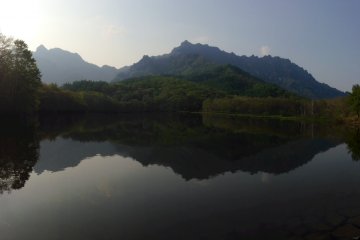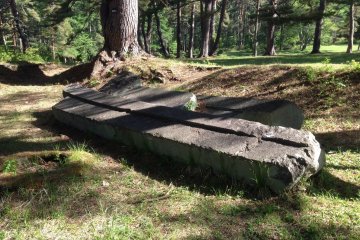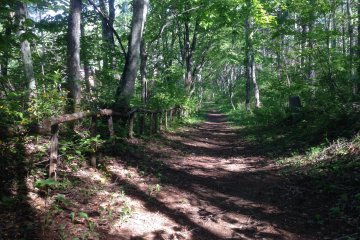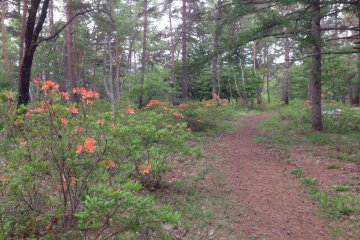Visitor's to famous Shinto shrines such as Kyoto's Heian Jingu or Itsukushima Shrine on Miyajima would be familiar with the large torii gates marking their entrances. Often standing in a series, the first of these a visitor would pass through is often known as ichi-no-torii, or the "first gate". It is usually the biggest and the most impressive, often spanning a wide avenue and towering over all below.
But when visiting the shrines of Togakushi, in northern Nagano Prefecture, you'd be hard pressed to find the first torii gate. There are two reasons for this: 1) Its location is quite off the beaten path, and 2) The torii itself is a ruin.
Most visitors to Togakushi would arrive by car or bus, traveling the Togakushi Birdline. This modern route allows visitors to reach the locations of the various shrines in a fraction of the time it used to take on the ancient footpath. The footpath, known as the Old Togakushi Road, often runs parallel to the modern, paved road, and you can see it and its stone distance markers here and there as you drive along. But at several points on the journey, the old road leads off into the woods, and it is on one of these diversions where you will find the first torii of the Togakushi shrines.
The first torii is in Ichi-no-tori Enchi, or "First Gate Garden", in an area of Joshin-Etsu Kogen National Park. To find this wonderful, scenic and beautiful spot, drive or take the bus up to the Iizuna Tozan-guchi bus stop. This bus stop is the trailhead for climbing Mt. Iizuna, Nagano City's most prominent peak. Here you will find a large gravel parking lot across the road from the Nagano Country Club. From the west end of the parking lot (it's free to park here) you will find a well-worn unpaved road heading uphill into the woods. This is the Old Togakushi Road. Walk up a few hundred meters until the road levels off. Just before the road starts going downhill, look to the right. There is the torii, or what's left of it. Its top and the six foundation holes -- which can be seen on both sides of the path you are on -- are all that remain.
Originally a wooden structure, the stone torii was erected in 1790 as a solution to the problem of having to rebuild every handful of decades due to exposure to the elements. In 1847, the Great Zenkoji Earthquake destroyed the stone torii and its pieces have been laying here ever since. A wooden replacement was constructed in 1886 and this stood until 1985, when it was finally dismantled due to its deterioration from years of wind, rain, heavy snowfall and fog. Since then, no torii has stood here.
So why go up here to see a torii that isn't even there anymore? The surprise is the surrounding park land. Next to the site of the torii is a large grassy lawn with a delightful view of Mt. Iizuna. Beyond that are several walking paths heading into the surrounding forest, where you can see azaleas and hostas growing in the wild. Take a stroll along any of these paths. It is easy to find your way back to where you started.
On the opposite side of the Old Togakushi Road is a field that used to offer a sweeping view of the Togakushi Mountain Range, but the surrounding tree line has, in recent years, partially obscured that view. If you plan on visiting in the winter, note that you will need snowshoes or cross-country skis. And in the winter, the area's heavy snowfall will completely cover the ruins of the torii.
Facilities available include restrooms, water fountains, a few picnic tables and a picnic pavilion or two. Admission and parking are free.











